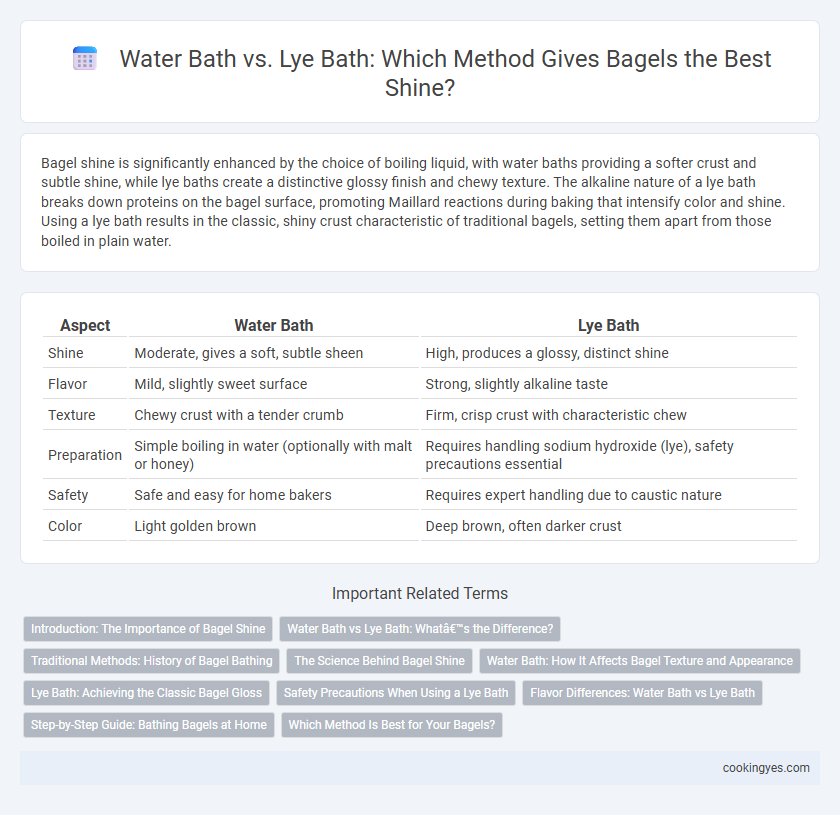Bagel shine is significantly enhanced by the choice of boiling liquid, with water baths providing a softer crust and subtle shine, while lye baths create a distinctive glossy finish and chewy texture. The alkaline nature of a lye bath breaks down proteins on the bagel surface, promoting Maillard reactions during baking that intensify color and shine. Using a lye bath results in the classic, shiny crust characteristic of traditional bagels, setting them apart from those boiled in plain water.
Table of Comparison
| Aspect | Water Bath | Lye Bath |
|---|---|---|
| Shine | Moderate, gives a soft, subtle sheen | High, produces a glossy, distinct shine |
| Flavor | Mild, slightly sweet surface | Strong, slightly alkaline taste |
| Texture | Chewy crust with a tender crumb | Firm, crisp crust with characteristic chew |
| Preparation | Simple boiling in water (optionally with malt or honey) | Requires handling sodium hydroxide (lye), safety precautions essential |
| Safety | Safe and easy for home bakers | Requires expert handling due to caustic nature |
| Color | Light golden brown | Deep brown, often darker crust |
Introduction: The Importance of Bagel Shine
Bagel shine is a key indicator of quality that enhances visual appeal and signals proper crust development. Water baths create a mild surface moisture that yields a matte finish, while lye baths chemically react with the dough surface to produce a distinctive, glossy sheen. The choice between water and lye baths directly impacts texture, taste, and the characteristic shine essential to authentic bagels.
Water Bath vs Lye Bath: What’s the Difference?
Water bath and lye bath both impact bagel shine and texture, but lye bath creates a glossy, deep brown crust due to the alkaline pH enhancing Maillard reactions, while water bath results in a softer, less shiny surface. Lye baths, typically using food-grade sodium hydroxide, require careful handling for safety but yield traditional-style bagels with a distinctive chewy crust. In contrast, water baths offer a safer, milder alternative producing bagels with a less pronounced shine and a slightly softer bite.
Traditional Methods: History of Bagel Bathing
Traditional bagel bathing methods include water baths and lye baths, each impacting the crust's texture and shine. The lye bath, a century-old technique rooted in Eastern European Jewish baking, chemically alters the dough's surface, producing a glossy, crisp crust prized in authentic bagels. Water baths, while simpler, offer a less pronounced sheen and are often favored for a softer crust, reflecting regional and historical variations in bagel preparation.
The Science Behind Bagel Shine
The science behind bagel shine hinges on the type of bath used during preparation, with water baths steaming the dough surface to create a soft crust, while lye baths chemically modify the starches and proteins via alkaline hydrolysis, resulting in a glossy, golden-brown exterior. Lye, a strong alkaline solution, raises the pH of the dough surface, promoting Maillard reactions during baking that enhance both color and texture. The controlled use of alkalinity in the bath is critical for achieving the classic bagel shine and chewy crust that distinguish traditional bagels from other bread products.
Water Bath: How It Affects Bagel Texture and Appearance
Water bath for bagels creates a chewier texture and a matte, less glossy appearance compared to a lye bath. The boiling water gelatinizes the starches on the bagel surface, promoting a dense crumb and soft crust while facilitating even browning during baking. This method is preferred for homemade bagels seeking a traditional, tender bite with a natural, understated finish.
Lye Bath: Achieving the Classic Bagel Gloss
Lye bath, containing a sodium hydroxide solution, is essential for achieving the classic bagel shine by creating a glossy, deep-brown crust through the Maillard reaction during baking. This alkaline bath enhances the bagel's texture and flavor more effectively than a simple water bath, promoting a distinctive, chewy exterior. Professional bakeries prefer lye baths because they ensure consistent gloss and a traditional appearance that water baths cannot replicate.
Safety Precautions When Using a Lye Bath
Using a lye bath for bagel shine enhances the crust's gloss and texture but requires strict safety precautions due to its caustic nature. Protective gloves, goggles, and proper ventilation are essential to prevent burns and inhalation hazards when handling sodium hydroxide solutions. Alternatives like a water bath offer safer, though less shiny, results, making lye baths preferable only for experienced bakers with proper safety equipment.
Flavor Differences: Water Bath vs Lye Bath
Water bath provides a mild, slightly sweet flavor with a soft crust, enhancing the natural taste of the bagel dough. Lye bath creates a distinctive, deep, savory flavor with a shiny, crisp crust due to the alkaline reaction during baking. Choosing between water and lye baths impacts not only the bagel's texture but also the depth and complexity of its traditional flavor profile.
Step-by-Step Guide: Bathing Bagels at Home
For a shiny crust, water bath and lye bath methods offer different results in bagel preparation. Begin by boiling bagels in water with added barley malt syrup or baking soda for a mild shine and chewy texture. Alternatively, immersion in a diluted lye solution creates a distinct glossy, deep brown appearance, but requires careful handling due to lye's caustic nature, emphasizing the importance of safety gloves and ventilation during this step.
Which Method Is Best for Your Bagels?
Water baths create a mild, neutral surface that helps bagels retain moisture and develop a slightly chewy crust, ideal for those who prefer a softer texture. Lye baths produce a distinctively shiny, deep brown crust with a traditional, slightly tangy flavor by creating a chemical reaction that enhances Maillard browning. For authentic bagels with a glossy finish and a complex taste, a lye bath is the best choice, while water baths suit those seeking a gentler, less intense crust.
Water bath vs lye bath for bagel shine Infographic

 cookingyes.com
cookingyes.com